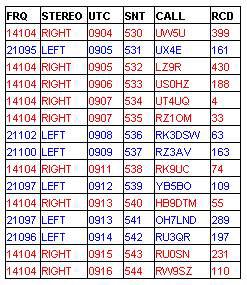 REF-CW SO2R DEMO
REF-CW SO2R DEMOThe story starts Saturday at 08:02Z, while everybody starts moving to 40, so the 80m rate is getting low...
Without SO2R you would move to 40m but with SO2R you can benefit from both bands!
The antennas used are the 2 dipoles shown on the picture below (above the OB6-3M) the dipoles are only separated by 1meter - The filtering is achieved by mean of ICE monoband filters on each radio. The obvious reason for selecting a CQ frequency as high as possible is getting the harmonic 2 to fall outisde the CW band (2x 3542 = 7084). The power is 100W (but it works also pretty well with 500W).
I wrote the explanation below because, if you are not familar with the technique, it may look quite "mysterious". However in this configuration, the principle is simple A) at any given time, you only listen to 1 radio B) you never listen to your transmitted signal, but use this time to S&P on the second radio... (N1MM-software displays ïn "real time" on the screen what the PC is transmitting the only moment you monitor yourself is when you use the paddle...)
The time refers to the audio track (time displayed by your mp3 player)
L'histoire commence samedi a 8:02Z quand la bande 80 commence à se vider au profit du 40m. Sans SO2R la logique voudrait qu'on change de bande... avec le SO2R on peut jouer sur les 2 tableaux... Les antennes utilisées sont les 2 dipoles visibles sur la photo ci-dessous (aus dessus de la OB6-3M), seulement distants de 1m. Le filtrage est fait grace à 2 filtres monobandes ICE. La raison pour choisir une frequence assez haute sur 80, est evidente: faire que la H2 tombe en dehors de la bande CW (3542x2= 7084). La puissance utilisée est ici 100W sur chaque radio, mais l'expérience montre que ca marche également très bien à 500W.
J'ai écrit les explication ci-dessous parce que si vous n'êtes pas familier avec la technique tout ça peut paraitre extremement mystérieux... En fait dans cette configuration le principe est simple A) vous n'ecoutez qu'une seule radio à la fois B) vous n'ecoutez jamais ce que le PC transmets , mais vous utilisez le temps ainsi libéré pour chasser sur la seconde bande (avec N1MM une petite fenêtre affiche ce qui est transmis en temps réel). Le seul moment ou vous écoutez ce que vous transmettez c'est quand vous utilisez la clé... Le temps est le temps affiché par votre MP3 player. (je traduis pas la suite... ca doit pas être trop compliqué !)
at 00:00 radio1 (IC756) on 3542 QRL?
at 00:08 starting CQ on radio1
at 00:22 identified F5KDC as new multiplier on 7027 (radio2: IC735)
at 00:30 F6HLE replies to my CQ on 3542
at 00:34 Sending report to F6HLE (while F5KDC is working HB9CHY on 7027)
at 00:54 QSO with F6HLE completed / sending QRZ
at 01:01 DL2RUG calling on 3542 (F5KDC working LY2FN on 7027)
at 01:34 DL2RUG sending report 599 002
at 01:48 F8NZQ calling on 3542
at 02:06 sending from paddle on 3542 (the only moment I listen to what I am sending !)
at 02:19 CQ on 3542 (F5KDC still busy !)
at 02:33 no reply on 80 - calling F5KDC on 40m
at 03:03 sending report to F5KDC - 80m still quiet
at 03:19 found F6AEW on 7026 - 53 is a new multiplier...
at 03:25 F5LGF calls me on 80m
at 03:32 Sending report to F5LGF (F6AEW still calling without success)
at 03:39 F5LGF sending my report
at 04:03 calling F6AEW on 40m
at 04:17 repeating my call slowlier (nothing on 80m...)
at 04:25 F6AEW sending my report (in the meantime I am sending CQ again on 80m...)
at 05:15 still quiet on 3542, LX6T CQ'ing on 7024
at 05:24 calling LX6T
at 05:39 QSO with LX6T completed... (wish all QSO's could be that fast and clean!)
at 06:05 someone sending 599 01 that's a new mult !
at 07:13 finaly somone heard my CQ on 3542! IK1RQQ calling me...
at 07:38 It's F6KAR on 7023
at 07:49 calling F6KAR
at 08:04 QSO completed with F6KAR - resuming CQ on 80m
at 08:13 Call from F5BBD on 80m
at 08:38 using the paddle to complete QSO with F5BBD (identified F8BBL on 7022)
at 08:56 F6HZS calling on 3542
at 09:30 QSO completed / DL1RTD calling me on 3542
at 10:32 Calling F8BBL on 7022
at 10:49 QSO completed with F8BBL - resuming CQ on 80
at 11:14 Nil on 80m - F6KPQ/P CQ'in on 7019
at 11:30 Calling KPQ but DL5YL also ! (the LP handicap... DL5YL gets first)
at 12:07 still quiet on 80m calling KPQ again...
at 12:10 this time is the good one !
END of the STORY: 8 QSO logged on 80m / 6 on 40m







